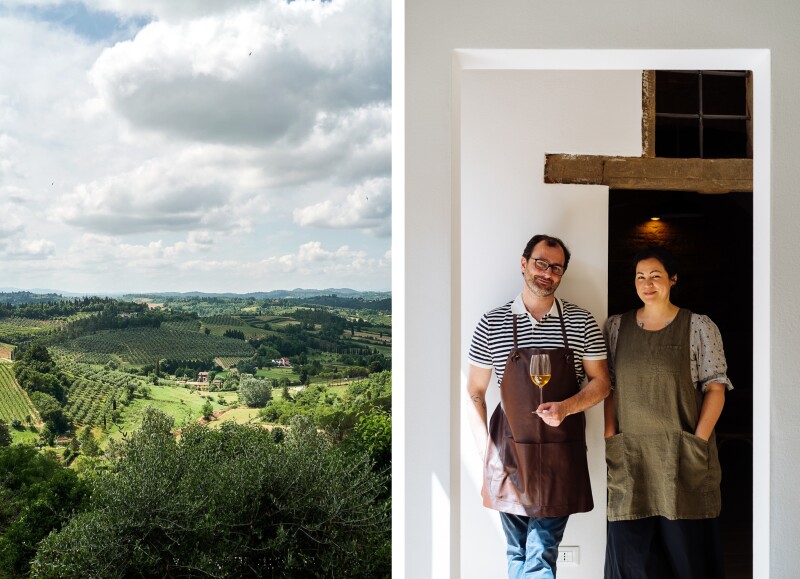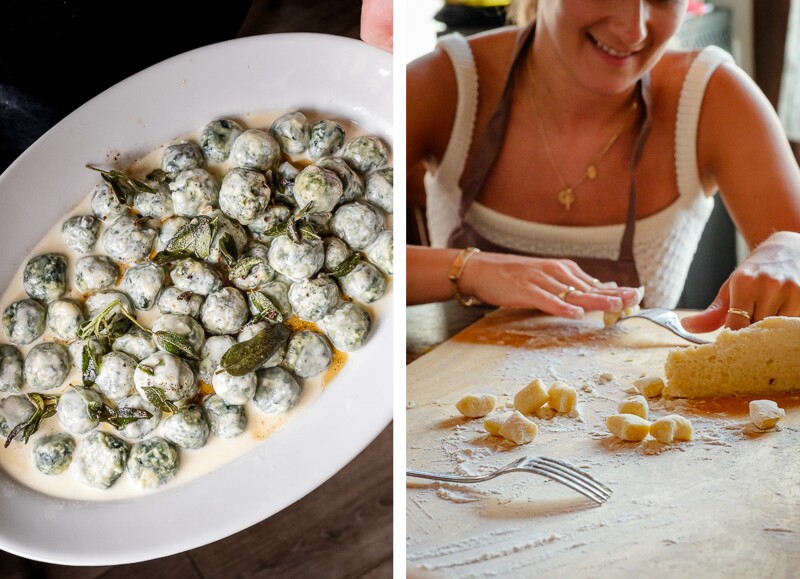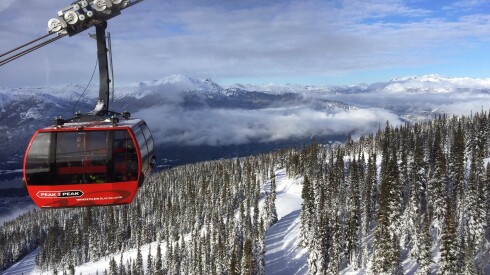Tuscany may conjure dreams of postcard-perfect views of rolling hills dotted by cypress trees, medieval villages, Renaissance palaces, and vineyards with neat rows of vines, but as one of Italy’s most visited regions, it also suffers from overtourism. As a Rome-based journalist, I’ve been to Tuscany dozens of times, in all seasons, and have gotten to know hoteliers, cookbook authors, fellow journalists, and regular people who live there. I’ve seen how a housing crisis caused by Airbnb is pushing locals out of the center of Florence, heard people derisively refer to Chianti as “Chiantishire” because so many Brits have bought crumbling villas in the area, and listened to Italians lament how their favorite restaurants have become impossible to get into.
Just when I’m about to write off the region entirely, though, I’ll follow a tip from a local friend and discover something I might never have heard of otherwise. So believe me, you can still experience an authentic side of Tuscany far from the crowds; you just might have to venture a bit farther off the beaten path than you otherwise would. Here are several ideas for how to do so.

Marilu is an enoteca and cooking school run by a cookbook author and a sommelier.
Courtesy of Marilu
Wander the streets of a town you’ve never heard of
It’s easy to get hung up on Tuscany’s bucket-list sights and forget that the region is huge and varied in terms of its landscape and offerings. You can soak in thermal hot springs in Saturnia and the Val d’Orcia, swim and sunbathe on the Versilia Coast, Maremma, and Argentario, visit the quarries where Michelangelo sourced his marble, and hike in the Apuan Alps. Oenophiles may want to check the towns of Chianti and Montalcino off of their lists, but there are plenty of wineries in less crowded areas, like Bolgheri.
“Tuscany is full of so many beautiful places to see, historical centers, and medieval hilltop towns,” says Emiko Davies, an Australian Japanese cookbook author who runs Marilu, a wine bar and cooking school along with her husband, Marco Lami, in his hometown of San Miniato. “It’s absolutely packed full, but tourists are really concentrated in a handful of places, and once you get out of those places, I think there’s a lot to discover.” Davies has noticed that while Florence, Siena, and San Gimignano groan under the weight of overtourism, owners of small businesses in less famous places want tourists to visit but don’t know how to attract them. “San Miniato doesn’t have a big monument or museum, like Florence, Pisa, or Siena, but I think it’s a nice place to soak in what Italian life is like,” she says. “And I think that’s something that people are also looking for when they’re traveling.”
In fact, there’s often an under-the-radar town not far from a more famous place. “Lucca is an incredible city that I always recommend our guests visit, as opposed to Pisa,” says Sara Maestrelli, who grew up in Florence and runs Collezione Em, a group of five boutique hotels in Florence, Forte dei Marmi, and Venice, with her family.
I recently stayed at Pensione America, Maestrelli’s new luxury hotel in the popular seaside town of Forte dei Marmi, and she suggested I visit the nearby town of Pietrasanta, which is full of art galleries, independent boutiques, sidewalk cafés, and charming restaurants. I sought out a little church where Colombian artist Fernando Botero painted a pair of murals, popped into a handful of boutiques, and enjoyed a lovely dinner with my husband in the garden of Da Giacomo. “There’s a huge concentration of art galleries and art shows,” Maestrelli says of the town, which has a population of around 23,000. “It has a very special vibe, because there are cute little restaurants and that beautiful square where you’re sitting, having a Negroni, and the sun goes down, and everything becomes pink, and you can kind of feel the magic.”

Giulia Scarpaleggia offers cooking classes from her home in Colle di Val d’Elsa.
Courtesy of Giulia Scarpaleggia
Seek out experiences that immerse you in local craft and cuisine
Plenty of companies offer tours of Tuscany’s historic sites, but I prefer to seek out more immersive, hands-on experiences. Last year, for example, I brought a group of family and friends to do a winetasting at Antinori Nel Chianti Classico—a stunning example of modern architecture from one of Italy’s oldest and most revered winemaking families—and a cooking class with Giulia Scarpaleggia, a cookbook author who teaches out of her home in Colle di Val d’Elsa. We spent the morning learning to make cecina (a chickpea pancake common in northern Tuscany and Liguria), chicken cacciatore, and olive oil cake, and even my dad—who normally doesn’t cook—enthusiastically rolled fresh pici pasta under Scarpaleggia’s tutelage.
On my first visit to Forte dei Marmi, I took Maestrelli’s tip and had a pair of wooden-soled sandals made to measure by Massimo Martini, who runs a little bottega called Giovanni del Forte. And on a recent trip to Florence, I ventured over to a quiet part of the city and created my own signature scent at a Profumoir perfume-making workshop.
In San Miniato, meanwhile, Davies and Lami offer cooking classes, wine lessons, and five-day food- and wine-focused workshops at Enoteca Marilu. “We’re very local, so we can show people the local producers, we can go truffle hunting,” Davies says, explaining that depending on the season, she brings people to visit local farmers growing artichokes, figs, ancient grains, or saffron, as well as cheesemakers and an olive oil mill. “That’s the beauty of being in the countryside—you’re so close to all of these incredible producers.”
Eat where the locals eat—even if you have to get out of town
Maestrelli used to rave about Trattoria Cammillo in Florence, but it became impossible to get a table and the quality declined, so eventually she decided to keep her favorite restaurants under wraps (or at least refrain from posting about them on social media). Davies notes that Florentines don’t have the patience to queue, so if you see a long line of people waiting outside a sandwich shop or a wine window, they’re tourists. For every viral sandwich shop, there’s an equally good hole-in-the-wall where you won’t have to wait 40 minutes for a panino.
A fine way to have a wonderful lunch, according to Maestrelli, is to head into the countryside just outside of Florence. “It’s very typical of the way we live,” she notes, adding that there are many rustic restaurants she takes family and friends for bistecca fritta (fried steak) and other local specialties. “If it’s a little bit sunny on a Saturday or Sunday, we’ll take the car and go somewhere for lunch that can even be literally 20 minutes away from town.”
For her part, Davies loves to dine at agriturismi (working farms that have a restaurant or small inn attached) to eat fresh food grown on-property and support local farmers. She also recommends putting down the Michelin guide and picking up a Slow Food Guide. “I’ve discovered so many great restaurants through them, because these are restaurants that care,” she explains. “They’re using Slow Food products, which is usually an heirloom breed or an old tradition. It might be a type of salumi or cheese that is from that place and needs to be protected in order for the tradition to continue.”

Florence’s Grand Hotel Minerva is right by the Santa Maria Novella church. It’s a family-run affair, and staff offer recommendations for less touristy things to see and do.
Courtesy of Grand Hotel Minerva
Book boutique accommodations, not Airbnbs
Davies and many others have been driven out of Florence due to the ongoing housing crisis, so if you want to support the local economy and protect the historic character of Tuscan cities, stay at hotels, not Airbnbs, which are monopolizing Florence’s housing stock and driving up rent prices. Not only do hotels provide jobs for locals but they also have concierges who can provide valuable insights and help you make restaurant reservations and organize activities.
When I ask Maestrelli how her hotels help guests experience a more authentic side of Tuscany, she replies, “It’s very simply the magic of a family-owned hotel. There’s no special trick to it. It’s simply sitting down together and having a coffee and trying to figure out what they want to do, like a conversation with friends.” Even at her family’s hotels in Florence—Grand Hotel Minerva and Hotel Brunelleschi—where there’s more guest turnover than at her seaside hotels, she makes sure that the concierges only recommend places that have been personally vetted, not ones that offer a kickback.
Go in the off-season
Florence used to empty out in August—when Italians head for the beach en masse—but not anymore, thanks to all the tourists. If you want my advice, avoid visiting the cities in summer, when the heat and crowds are at their peak. If that’s the only time you can go, check to see if museums and other attractions have extended opening hours. Last July, I went to the Uffizi Galleries on a Tuesday evening, when the museum was open until 10 p.m., and admired paintings by Raphael and Botticelli without the crush of tour groups.
Davies tells me her favorite season in Tuscany is the fall, when mushrooms and squash appear on restaurant tables, and San Miniato hosts an annual white truffle festival. She notes that pilgrims tend to come through the town with their walking sticks in the spring and fall, as it lies on the Via Francigena, an old pilgrim route from Canterbury to Rome.
Spring and fall can also be preferable for visiting the coast, to avoid coinciding with Italian beach season. Just keep in mind that some resorts close for the winter, typically from October or November until around Easter. For what it’s worth, winter is the only true off-season in Tuscany, but the weather tends to be mild, making January through March a good time to experience Florence, Siena, and other popular cities like a local.











